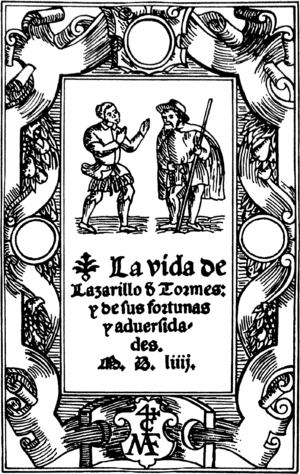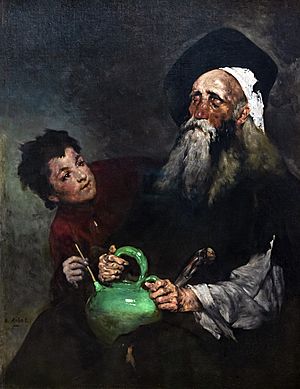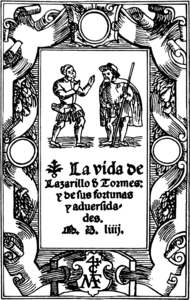Lazarillo de Tormes facts for kids

Title page of the 1554 edition
|
|
| Author | anonymous |
|---|---|
| Original title | La vida de Lazarillo de Tormes y de sus fortunas y adversidades |
| Country | Spain |
| Language | Spanish |
| Genre | Picaresque |
|
Publication date
|
1554 |
| Media type | Print (Hardback & Paperback) |

The Life of Lazarillo de Tormes and of His Fortunes and Adversities is a famous Spanish novella. It was first published in 1554. The author chose to remain anonymous. This was likely because the book openly criticized some church practices.
The book was published in three cities at the same time: Alcalá de Henares, Burgos, and Antwerp. The version from Alcalá de Henares included extra parts. These were probably added by another writer. Lazarillo de Tormes is well-known for starting a new type of story. This style is called the picaresque novel.
Contents
What is Lazarillo de Tormes About?
The story follows a young boy named Lázaro. He comes from a poor family in Salamanca, Spain. After his stepfather gets into trouble, Lázaro's mother sends him to work. He becomes an apprentice to a clever blind beggar.
Lázaro learns to be cunning and resourceful while serving this beggar. He then works for several other masters. Each new master teaches him more about life and how to survive.
Lázaro's Adventures: Chapter by Chapter
The book is divided into chapters, often called "treatises." Each chapter tells about Lázaro's time with a different master.
- Prologue: Lázaro introduces himself and his story.
- Chapter 1: His childhood and learning from the blind man.
- Chapter 2: Serving a priest.
- Chapter 3: Working for a poor squire who pretends to be rich.
- Chapter 4: Serving a friar.
- Chapter 5: Working for a pardoner, who sells special church papers.
- Chapter 6: Serving a chaplain.
- Chapter 7: His final masters, a pardoner and an archpriest.
Why is This Book Important?
Lazarillo de Tormes is very important in Spanish literature. It helped create the picaresque novel style. The word pícaro means "rogue" or "rascal" in Spanish.
In these types of novels, a clever main character goes on adventures. Their journey often shows the unfairness of society. But it also makes the reader laugh. Other famous picaresque novels include Tom Jones and Adventures of Huckleberry Finn.
Why Was the Book Banned?
The Spanish Crown and the Spanish Inquisition banned Lazarillo de Tormes. The Inquisition was a powerful religious court. They put the book on their Index of Forbidden Books. This was mainly because the book criticized some church leaders and their actions.
In 1573, a shorter version was allowed. It removed chapters 4 and 5 and other parts. The full book was not available in Spain until the 1800s. However, the complete version from Antwerp was translated into many languages. It spread across Europe.
- Spanish first edition title pages in 1554 of ''Lazarillo de Tormes''.
-
Burgos, Juan de Junta
-
Medina del Campo, Hermanos Del Canto
-
Alcalá de Henares, Salcedo
-
Antwerp, Martín Nucio
What Makes Lazarillo Special?
Lazarillo was different from other books of its time. Most stories were about brave knights and amazing adventures. But Lazarillo showed the real, tough life of poor people. It gave a "worm's eye view" of society. This means it showed life from the perspective of someone struggling at the bottom.
The book also introduced a new way to describe different jobs and social classes. Lázaro, a young boy, describes his masters. He uses simple, honest details. He often calls them by their job, like "the blind man" or "the squire." This makes them seem like types of people, not just individuals.
Lázaro's Name and Family
Only Lázaro and his family have real names in the story. His mother is Antoña Pérez. His father is Tomé Gonzáles. His stepfather is El Zayde.
Lázaro's last name, de Tormes, comes from the Tormes river. He explains that he was born right by the river. His father worked at a mill there. The Tormes river flows through Lázaro's hometown, Salamanca. There's even a statue of Lázaro and the blind man near the old Roman bridge in the city.
The name Lazarillo is a smaller version of the Spanish name Lázaro. There are two stories about a person named Lazarus in the Bible. One is about Jesus raising Lazarus from the dead. The other is a story about a poor beggar named Lazarus. Many people think the author chose the name to connect Lázaro to the idea of a struggling beggar.
New Ideas in Literature
Lazarillo de Tormes was groundbreaking in many ways:
- It was one of the first books to treat a boy like a real boy. It showed his thoughts and feelings, not just as a small adult. This was long before books like Oliver Twist or Huckleberry Finn.
- It described the daily life of a poor woman. It showed her struggles as a wife and mother. This was unusual for its time.
- The author also showed an interracial family. He described their joys and pains. This was a very new idea for literature back then.
Criticism of Society
The author of Lazarillo used the story to criticize many groups. He especially focused on the Catholic Church and the Spanish aristocracy (the noble class).
Lázaro's different masters show these criticisms. For example, the cleric only cared about feeding himself. The squire pretended to be rich but couldn't even feed himself or Lázaro. This made fun of how important it was for nobles to look good, even if they were poor.
In the last chapter, Lázaro works for an Archpriest. The Archpriest even arranges for Lázaro to marry his maid. This part of the story also hints at problems within the church.
Who Wrote Lazarillo?
The author of Lazarillo has been a mystery for hundreds of years. Because the book criticized the church, the author probably stayed anonymous. This was to avoid religious punishment.
No one knows for sure who wrote it or exactly when and where it was first published. Some people thought it was a monk named Fray Juan de Ortega. Others believed it was Diego Hurtado de Mendoza. Recently, new documents have been found. These documents seem to support the idea that Diego Hurtado de Mendoza was indeed the author.
Other Lazarillo Stories
Just one year after the first book, a sequel appeared in 1555. It was printed in Antwerp. This story is called El Lazarillo de Amberes.
In this sequel, Lázaro leaves his family. He joins the Spanish army. His ship sinks, but Lázaro survives by drinking so much wine that he floats! He then turns into a tuna fish. The book tells about his adventures as a tuna.
In 1620, another sequel was written by Juan de Luna. This author said the tuna story was false. His book told a different continuation of Lázaro's life.
Lazarillo in Movies and Plays
Lazarillo de Tormes has been adapted many times.
- 1617: A play called Spaansche Brabander by Gerbrand Adriaenszoon Bredero.
- 1959: A film adaptation called El Lazarillo de Tormes.
- 1973: A Soviet Georgian adaptation, The Adventures of Lazare.
- 1987: A loose film adaptation, The Rogues.
- 2001: A film adaptation, Lázaro de Tormes.
- 2015: An animated movie, El lazarillo de Tormes.
Lazarillo's Lasting Impact
Because of Lázaro's first adventures as a guide, the Spanish word lazarillo now means "guide." It is often used for someone who guides a blind person. Even today, a guide dog is sometimes called a perro lazarillo in Spanish.
See also
 In Spanish: La vida de Lazarillo de Tormes para niños
In Spanish: La vida de Lazarillo de Tormes para niños





